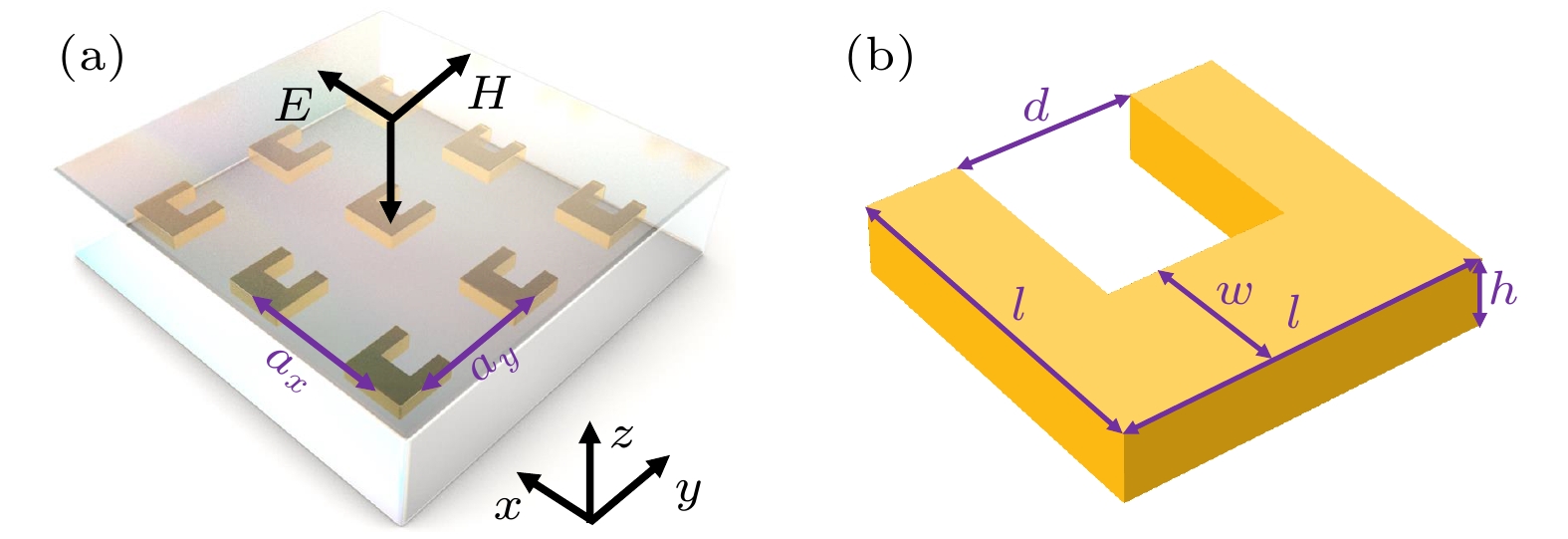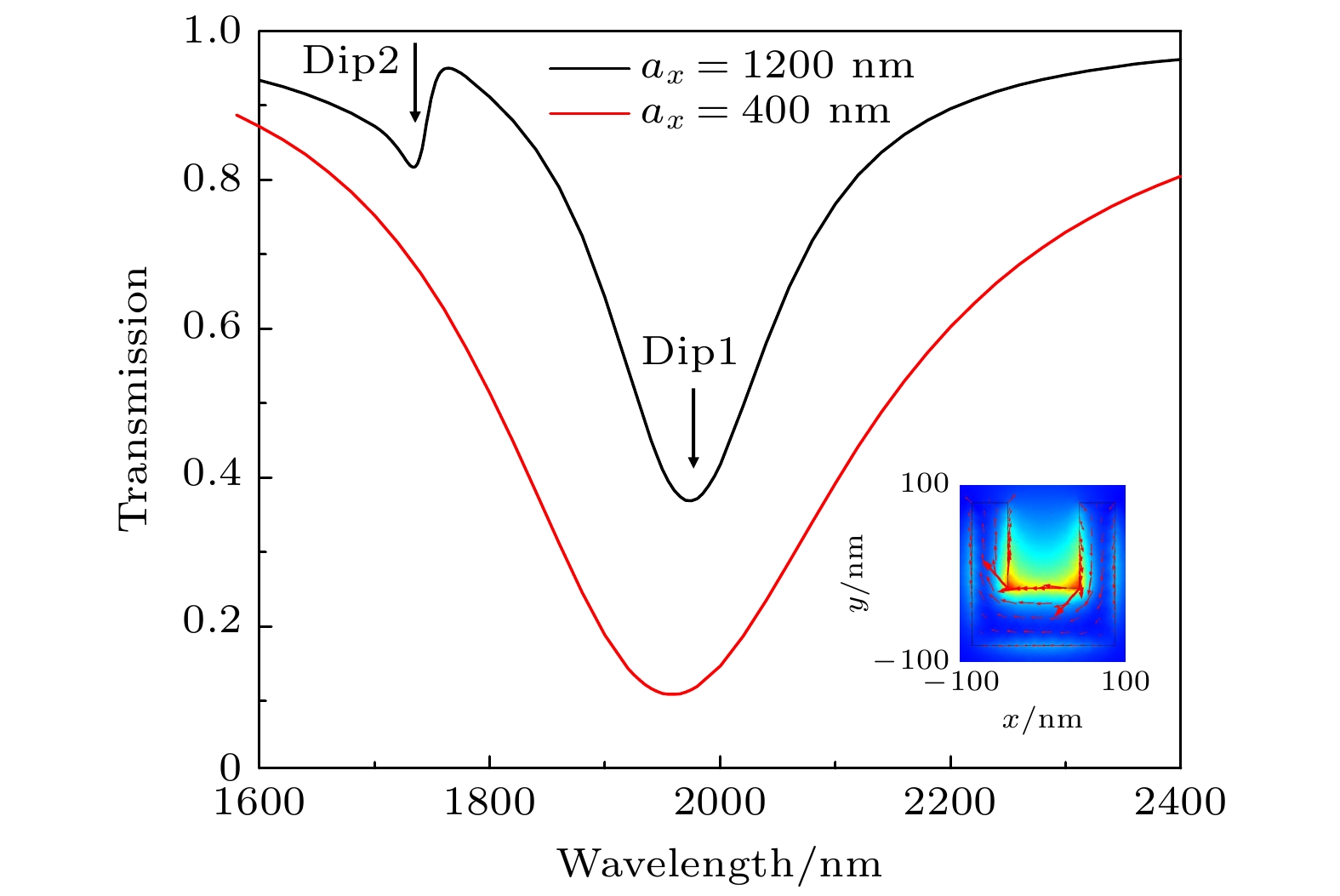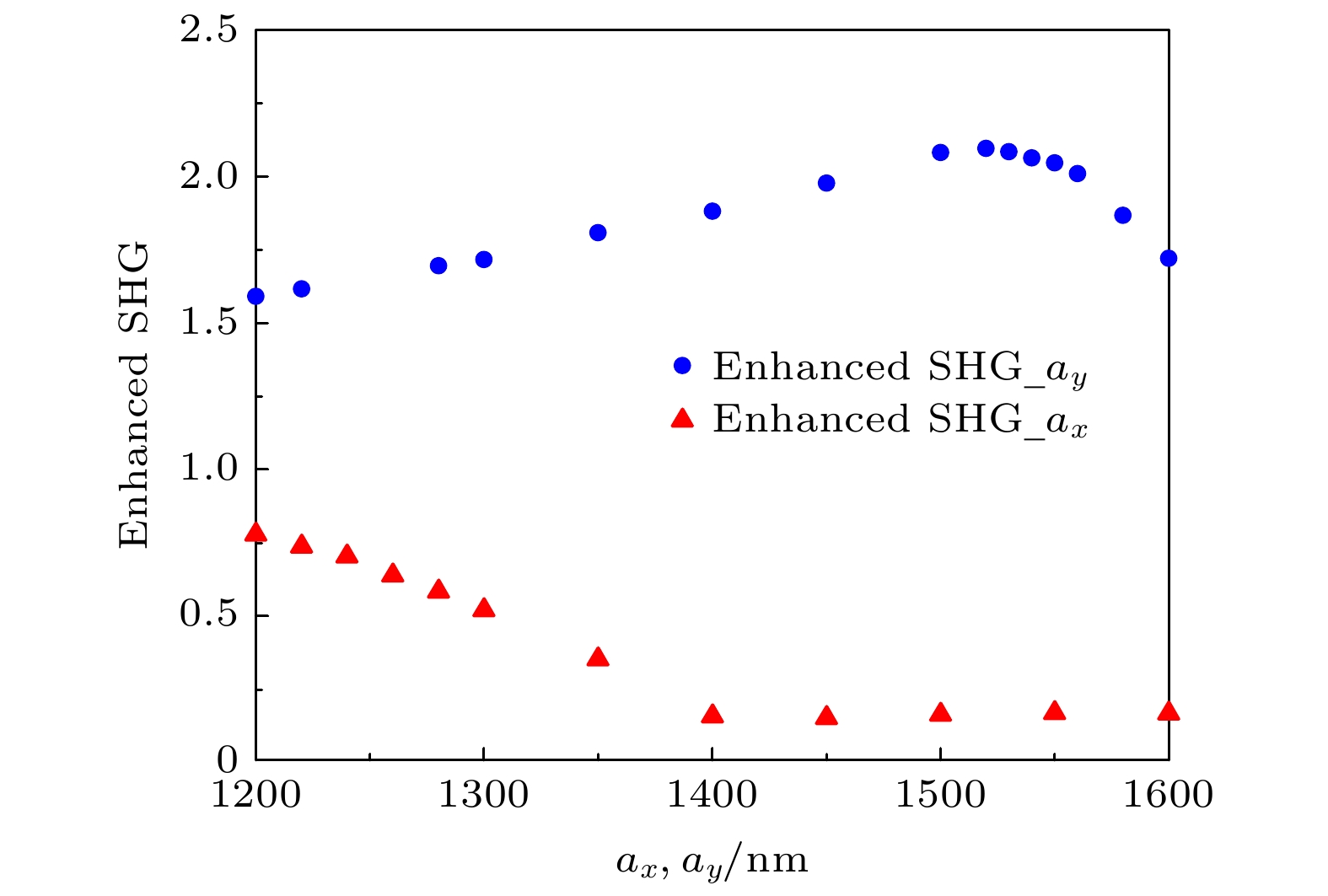-
In this paper, we theoretically study the condition for the strong coupling between magnetic resonance mode of the two-dimensional periodically arranged gold split-ring resonators and the diffraction mode of the periodic array and its influence on the second harmonic generation efficiency. By controlling the size of the period of the array structure in the x-axis and y-axis, the diffraction mode is excited near the magnetic resonance provided by the gold split-ring resonator, solely in one of the directions. In both cases, the diffraction mode and the magnetic resonance coincide in the linear resonance spectrum, but by analyzing the electric field distribution at the position of the diffraction mode, it can be found that when
${a_x}$ is much larger than${a_y}$ , the electric field direction of the diffraction mode is perpendicular to the polarization direction of the incident light, and no strong coupling occurs. Therefore, the dilution effect is dominant, and the second harmonic intensity gradually decreases with the increase of the period. When${a_y}$ is much larger than${a_x}$ , the electric field direction of the diffraction mode is the same as the polarization direction of the incident light. At this time, the diffraction mode and the magnetic resonance mode are strongly coupled. As the period increases, the second harmonic intensity first increases and then decreases. The increase is due to the dominant mode coupling and the decrease is due to the dominant dilution effect. When the number density of split-ring resonators is reduced to about 1/4 of the original one, the second harmonic intensity can be increased by more than twice. From this, we find that the strong coupling between diffraction mode and magnetic resonance can occur when the electric field direction of the diffraction mode is consistent with the polarization direction of incident light, thus generating the surface lattice resonance to achieve near-field enhancement. In short, the rectangular periodic structure is used to distinguish the field enhancement effects in different directions, and the second harmonic enhancement can still be achieved when the number density of split-ring resonators is reduced, which relaxes the requirements for processing technology. This research provides a new possible way to improve the second harmonic generation efficiency based on metal metasurfaces.-
Keywords:
- strong coupling /
- gold split-ring resonators /
- diffraction mode /
- second harmonic
[1] Zayats A V, Smolyaninov I I, Maradudin A A 2005 Phys. Rep. 408 131
 Google Scholar
Google Scholar
[2] Stockman M I 2011 Opt. Express 19 22029
 Google Scholar
Google Scholar
[3] Piliarik M, Sipova H, Kvasnicka P, Galler N, Krenn J R, Homola J 2012 Opt. Express 20 672
 Google Scholar
Google Scholar
[4] Byun K M, Yoon S J, Kim D, Kim S J 2007 Opt. Lett. 32 1902
 Google Scholar
Google Scholar
[5] Clementi N C, Cooper C D, Barba L A 2019 Phys. Rev. E 100 063305
 Google Scholar
Google Scholar
[6] Chang C Y, Lin H T, Lai M S, Shieh T Y, Peng C C, Shih M H, Tung Y C 2018 Sci. Rep. 8 11812
 Google Scholar
Google Scholar
[7] Kim H M, Park J H, Lee S K 2019 Sci. Rep. 9 15605
 Google Scholar
Google Scholar
[8] Shen Y, Zhou J H, Liu T R, Tao Y T, Jiang R B, Liu M X, Xiao G H, Zhu J H, Zhou Z K, Wang X H, Jin C J, Wang J F 2013 Nat. Commun. 4 2381
 Google Scholar
Google Scholar
[9] Brolo A G 2012 Nat. Photonics 6 709
 Google Scholar
Google Scholar
[10] Wang T J, Chang H W, Chen J S, Chiang H P 2019 Sci. Rep. 9 10962
 Google Scholar
Google Scholar
[11] Lin K Q, Yi J, Zhong J H, Hu S, Liu B J, Liu J Y, Zong C, Lei Z C, Wang X, Aizpurua J, Esteban R, Ren B 2017 Nat. Commun. 8 14891
 Google Scholar
Google Scholar
[12] Boerigter C, Campana R, Morabito M, Linic S 2016 Nat. Commun. 7 10545
 Google Scholar
Google Scholar
[13] Davis T J, Gomez D E, Vernon K C 2010 Phys. Rev. B 82 205434
 Google Scholar
Google Scholar
[14] Carles R, Bayle M, Benzo P, Benassayag G, Bonafos C, Cacciato G, Privitera V 2015 Phys. Rev. B 92 174302
 Google Scholar
Google Scholar
[15] Grand J, de la Chapelle M L, Bijeon J L, Adam P M, Vial A, Royer P 2005 Phys. Rev. B 72 033407
[16] Huttunen M J, Rasekh P, Boyd R W, Dolgaleva K 2018 Phys. Rev. A 97 053817
 Google Scholar
Google Scholar
[17] Michaeli L, Keren-Zur S, Avayu O, Suchowski H, Ellenbogen T 2017 Phys. Rev. Lett. 118 243904
 Google Scholar
Google Scholar
[18] Li Z, Xu C K, Liu W J, Li M, Chen X J 2018 Sci. Rep. 8 5626
 Google Scholar
Google Scholar
[19] Jin B Y, Argyropoulos C 2016 Sci. Rep. 6 28746
 Google Scholar
Google Scholar
[20] Kauranen M, Zayats A V 2012 Nat. Photonics 6 737
 Google Scholar
Google Scholar
[21] Li G, Zhang S, Zentgraf T 2017 Nat. Rev. Mater. 2 17010
 Google Scholar
Google Scholar
[22] Yu H K, Peng Y S, Yang Y, Li Z Y 2019 Npj Comput. Mater. 5 45
 Google Scholar
Google Scholar
[23] Thackray B D, Kravets V G, Schedin F, Anton G, Thomas P A, Grigorenko A N 2014 ACS Photonics 1 1116
 Google Scholar
Google Scholar
[24] Zhou W, Dridi M, Suh J Y, Kim C H, Co D T, Wasielewski M R, Schatz G C, Odom T W 2013 Nat. Nanotechnol. 8 506
 Google Scholar
Google Scholar
[25] Vakevainen A I, Moerland R J, Rekola H T, Eskelinen A P, Martikainen J P, Kim D H, Torma P 2014 Nano Lett. 14 1721
 Google Scholar
Google Scholar
[26] Vecchi G, Giannini V, Rivas J G 2009 Phys. Rev. Lett. 102 146807
 Google Scholar
Google Scholar
[27] Lozano G, Louwers D J, Rodríguez S R K, Murai S, Jansen O T A, Verschuuren M A, Gómez Rivas J 2013 Light-Sci. Appl. 2 e66
[28] Czaplicki R, Kiviniemi A, Huttunen M J, Zang X R, Stolt T, Vartiainen I, Butet J, Kuittinen M, Martin O J F, Kauranen M 2018 Nano Lett. 18 7709
 Google Scholar
Google Scholar
[29] Ciracì C, Poutrina E, Scalora M, Smith D R 2012 Phys. Rev. B 85 201403
 Google Scholar
Google Scholar
[30] Tang C J, Zhan P, Cao Z S, Pan J, Chen Z, Wang Z L 2011 Phys. Rev. B 83 041402
[31] Czaplicki R, Kiviniemi A, Laukkanen J, Lehtolahti J, Kuittinen M, Kauranen M 2016 Opt. Lett. 41 2684
 Google Scholar
Google Scholar
[32] 靳悦荣, 陈卓, 王振林 2013 中国科学: 物理学 力学 天文学 43 1022
 Google Scholar
Google Scholar
Jin Y R, Chen Z, Wang Z L 2013 Sci. Sin-Phys. Mech. Astron. 43 1022
 Google Scholar
Google Scholar
[33] Klein M W, Enkrich C, Wegener M, Linden S 2006 Science 313 502
 Google Scholar
Google Scholar
[34] Linden S, Enkrich C, Wegener M, Zhou J, Koschny T, Soukoulis C M 2004 Science 306 1351
 Google Scholar
Google Scholar
-
图 1 (a) 处于均匀介质中的金开口环谐振器阵列结构示意图, x, y方向的周期分别为
${a_x}$ ,${a_y}$ , 入射光垂直照射于阵列结构, 电场方向沿x轴; (b) SRRs单元结构图, 其中$l = 200\;{\rm{nm}}$ ,$w = 80\;{\rm{nm}}$ ,$d = 100\;{\rm{nm}}$ ,$h = 30\;{\rm{nm}}$ Figure 1. (a) Schematic of SRRs array, the period of the x axis and y axis is
${a_x}$ and${a_y}$ , respectively, the incident light is perpendicular to the structure, and the electric field is along the x axis; (b) the unit cell of SRRs, where$l = 200\;{\rm{nm}}$ ,$w = 80\;{\rm{nm}}$ ,$d = 100\;{\rm{nm}}$ ,$h = 30\;{\rm{nm}}$ .图 2
${a_y} = 400\;{\rm{nm}}$ 固定不变,${a_x} = 1200\;{\rm{nm}}$ (黑线)和${a_x} = 400\;{\rm{nm}}$ (红线)两种不同周期阵列结构的透射谱, 插图表示宽带透射谷(Dip1)位置x-y截面的磁场电流分布图Figure 2. The transmission spectrum of two different periods along the x axis,
${a_x} = 1200\;{\rm{nm}}$ (black line) and${a_x} = 400 \;{\rm{nm}}$ (red line). The insert shows the distribution of magnetic field and current in x-y section at the position of Dip1.图 3
${a_y} = 400\;{\rm{nm}}$ ,${a_x} = 1200$ —1550 nm (间隔50 nm) 时的 (a) 线性透射谱及(b) 透射谱中两透射谷随周期的变化;${a_x} = 400\;{\rm{nm}}$ ,${a_y} = 1200$ —1500 nm (间隔50 nm)时的 (c) 线性透射谱及(d) 透射谱中两透射谷随周期的变化Figure 3. (a) Linear transmission spectrum and (b) the positions of two dips in transmission spectrum change with the period along the x axis,
${a_y} = 400\;{\rm{nm}}$ ,${a_x} = 1200\!-\!1550 $ nm (interval 50 nm); (c) linear transmission spectrum and (d) the positions of two dips in transmission spectrum change with the period along the y axis,${a_x} = 400\;{\rm{nm}}$ ,${a_y} = 1200\!-\! 1500$ nm (50 nm interval).图 4 (a)
${a_x} = 1300\;{\rm{nm, }}\;$ ${a_y} = 400\;{\rm{nm}}$ 的SRRs阵列在激发波长为λ = 1900 nm时$x \text- z$ 截面的电场模值(左)与电场x (中)和y (右)分量的场分布图; (b) 周期${a_y} = 1300\;{\rm{nm, }}\;{a_x} = 400\;{\rm{nm}}$ 的SRRs阵列在激发波长λ = 1900 nm时$y \text- z$ 截面的电场模值(左)与电场x (中)和y (右)分量的场分布图Figure 4. Calculated total (left) and x (middle) component and y (right) component of electric field amplitude distribution in
$x \text- z$ cross-section at λ = 1900 nm for (a)${a_x} = 1300\;{\rm{nm, }}\;$ ${a_y} = 400\;{\rm{nm}}$ and in$y \text- z$ cross-section at λ = 1900 nm for (b)${a_y} = 1300\;{\rm{nm, }} \;{a_x} = 400\;{\rm{nm}}$ .图 5 固定
${a_x} = 400\;{\rm{nm}}$ , 改变${a_y}$ (蓝色实心圆)和固定${a_y} = 400\;{\rm{nm}}$ , 改变${a_x}$ (红色实心三角)时SRRs阵列的二次谐波强度变化Figure 5. The second harmonic intensity of the SRRs array at fixed
${a_x} = 400\;{\rm{nm}}$ , variable${a_y}$ (blue circles) and fixed${a_y} = 400\;{\rm{nm}}$ , variable${a_x}$ (red triangles). -
[1] Zayats A V, Smolyaninov I I, Maradudin A A 2005 Phys. Rep. 408 131
 Google Scholar
Google Scholar
[2] Stockman M I 2011 Opt. Express 19 22029
 Google Scholar
Google Scholar
[3] Piliarik M, Sipova H, Kvasnicka P, Galler N, Krenn J R, Homola J 2012 Opt. Express 20 672
 Google Scholar
Google Scholar
[4] Byun K M, Yoon S J, Kim D, Kim S J 2007 Opt. Lett. 32 1902
 Google Scholar
Google Scholar
[5] Clementi N C, Cooper C D, Barba L A 2019 Phys. Rev. E 100 063305
 Google Scholar
Google Scholar
[6] Chang C Y, Lin H T, Lai M S, Shieh T Y, Peng C C, Shih M H, Tung Y C 2018 Sci. Rep. 8 11812
 Google Scholar
Google Scholar
[7] Kim H M, Park J H, Lee S K 2019 Sci. Rep. 9 15605
 Google Scholar
Google Scholar
[8] Shen Y, Zhou J H, Liu T R, Tao Y T, Jiang R B, Liu M X, Xiao G H, Zhu J H, Zhou Z K, Wang X H, Jin C J, Wang J F 2013 Nat. Commun. 4 2381
 Google Scholar
Google Scholar
[9] Brolo A G 2012 Nat. Photonics 6 709
 Google Scholar
Google Scholar
[10] Wang T J, Chang H W, Chen J S, Chiang H P 2019 Sci. Rep. 9 10962
 Google Scholar
Google Scholar
[11] Lin K Q, Yi J, Zhong J H, Hu S, Liu B J, Liu J Y, Zong C, Lei Z C, Wang X, Aizpurua J, Esteban R, Ren B 2017 Nat. Commun. 8 14891
 Google Scholar
Google Scholar
[12] Boerigter C, Campana R, Morabito M, Linic S 2016 Nat. Commun. 7 10545
 Google Scholar
Google Scholar
[13] Davis T J, Gomez D E, Vernon K C 2010 Phys. Rev. B 82 205434
 Google Scholar
Google Scholar
[14] Carles R, Bayle M, Benzo P, Benassayag G, Bonafos C, Cacciato G, Privitera V 2015 Phys. Rev. B 92 174302
 Google Scholar
Google Scholar
[15] Grand J, de la Chapelle M L, Bijeon J L, Adam P M, Vial A, Royer P 2005 Phys. Rev. B 72 033407
[16] Huttunen M J, Rasekh P, Boyd R W, Dolgaleva K 2018 Phys. Rev. A 97 053817
 Google Scholar
Google Scholar
[17] Michaeli L, Keren-Zur S, Avayu O, Suchowski H, Ellenbogen T 2017 Phys. Rev. Lett. 118 243904
 Google Scholar
Google Scholar
[18] Li Z, Xu C K, Liu W J, Li M, Chen X J 2018 Sci. Rep. 8 5626
 Google Scholar
Google Scholar
[19] Jin B Y, Argyropoulos C 2016 Sci. Rep. 6 28746
 Google Scholar
Google Scholar
[20] Kauranen M, Zayats A V 2012 Nat. Photonics 6 737
 Google Scholar
Google Scholar
[21] Li G, Zhang S, Zentgraf T 2017 Nat. Rev. Mater. 2 17010
 Google Scholar
Google Scholar
[22] Yu H K, Peng Y S, Yang Y, Li Z Y 2019 Npj Comput. Mater. 5 45
 Google Scholar
Google Scholar
[23] Thackray B D, Kravets V G, Schedin F, Anton G, Thomas P A, Grigorenko A N 2014 ACS Photonics 1 1116
 Google Scholar
Google Scholar
[24] Zhou W, Dridi M, Suh J Y, Kim C H, Co D T, Wasielewski M R, Schatz G C, Odom T W 2013 Nat. Nanotechnol. 8 506
 Google Scholar
Google Scholar
[25] Vakevainen A I, Moerland R J, Rekola H T, Eskelinen A P, Martikainen J P, Kim D H, Torma P 2014 Nano Lett. 14 1721
 Google Scholar
Google Scholar
[26] Vecchi G, Giannini V, Rivas J G 2009 Phys. Rev. Lett. 102 146807
 Google Scholar
Google Scholar
[27] Lozano G, Louwers D J, Rodríguez S R K, Murai S, Jansen O T A, Verschuuren M A, Gómez Rivas J 2013 Light-Sci. Appl. 2 e66
[28] Czaplicki R, Kiviniemi A, Huttunen M J, Zang X R, Stolt T, Vartiainen I, Butet J, Kuittinen M, Martin O J F, Kauranen M 2018 Nano Lett. 18 7709
 Google Scholar
Google Scholar
[29] Ciracì C, Poutrina E, Scalora M, Smith D R 2012 Phys. Rev. B 85 201403
 Google Scholar
Google Scholar
[30] Tang C J, Zhan P, Cao Z S, Pan J, Chen Z, Wang Z L 2011 Phys. Rev. B 83 041402
[31] Czaplicki R, Kiviniemi A, Laukkanen J, Lehtolahti J, Kuittinen M, Kauranen M 2016 Opt. Lett. 41 2684
 Google Scholar
Google Scholar
[32] 靳悦荣, 陈卓, 王振林 2013 中国科学: 物理学 力学 天文学 43 1022
 Google Scholar
Google Scholar
Jin Y R, Chen Z, Wang Z L 2013 Sci. Sin-Phys. Mech. Astron. 43 1022
 Google Scholar
Google Scholar
[33] Klein M W, Enkrich C, Wegener M, Linden S 2006 Science 313 502
 Google Scholar
Google Scholar
[34] Linden S, Enkrich C, Wegener M, Zhou J, Koschny T, Soukoulis C M 2004 Science 306 1351
 Google Scholar
Google Scholar
Catalog
Metrics
- Abstract views: 9153
- PDF Downloads: 164
- Cited By: 0





























 DownLoad:
DownLoad:



































